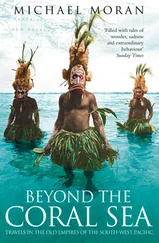The forest that covers the steep flank of the mountain of Santa Maria, is one of the thickest I ever saw. The trees are of stupendous height and size. Under their bushy, deep green foliage, there reigns continually a kind of dim daylight, a peculiar sort of obscurity, of which our forests of pines, oaks, and beech-trees, convey no idea. Notwithstanding its elevated temperature, it is difficult to believe that the air can dissolve the quantity of water exhaled from the surface of the soil, the foliage of the trees, and their trunks: the latter are covered with a drapery of orchideae, peperomia, and other succulent plants. With the aromatic odour of the flowers, the fruit, and even the wood, is mingled that which we perceive in autumn in misty weather. Here, as in the forests of the Orinoco, fixing our eyes on the top of the trees, we discerned streams of vapour, whenever a solar ray penetrated, and traversed the dense atmosphere. Our guides pointed out to us among those majestic trees, the height of which exceeded 120 or 130 feet, the curucay of Terecen. It yields a whitish liquid, and very odoriferous resin, which was formerly employed by the Cumanagoto and Tagiri Indians, to perfume their idols. The young branches have an agreeable taste, though somewhat astringent. Next to the curucay and enormous trunks of hymenaea, (the diameter of which was more than nine or ten feet), the trees which most excited our attention were the dragon's blood (Croton sanguifluum), the purple-brown juice of which flows down a whitish bark; the calahuala fern, different from that of Peru, but almost equally medicinal;* (* The calahuala of Caripe is the Polypodium crassifolium; that of Peru, the use of which has been so much extended by Messrs. Ruiz and Pavon, comes from the Aspidium coriaceum, Willd. (Tectaria calahuala, Cav.) In commerce the diaphoretic roots of the Polypodium crassifolium, and of the Acrostichum huascaro, are mixed with those of the calahuala or Aspidium coriaceum.) and the palm-trees, irasse, macanilla, corozo, and praga.* (* Aiphanes praga.) The last yields a very savoury palm-cabbage, which we had sometimes eaten at the convent of Caripe. These palms with pinnated and thorny leaves formed a pleasing contrast to the fern-trees. One of the latter, the Cyathea speciosa,* grows to the height of more than thirty-five feet, a prodigious size for plants of this family. (* Possibly a hemitelia of Robert Brown. The trunk alone is from 22 to 24 feet long. This and the Cyathea excelsa of the Mauritius, are the most majestic of all the fern-trees described by botanists. The total number of these gigantic cryptogamous plants amounts at present to 25 species, that of the palm-trees to 80. With the cyathea grow, on the mountain of Santa Maria, Rhexia juniperina, Chiococca racemosa, and Commelina spicata.) We discovered here, and in the valley of Caripe, five new kinds of arborescent ferns.* (* Meniscium arborescens, Aspidium caducum, A. rostratum, Cyathea villosa, and C. speciosa.) In the time of Linnaeus, botanists knew no more than four on both continents.
We observed that the fern-trees are in general much more rare than the palm-trees. Nature has confined them to temperate, moist, and shady places. They shun the direct rays of the sun, and while the pumos, the corypha of the steppes and other palms of America, flourish on the barren and burning plains, these ferns with arborescent trunks, which at a distance look like palm-trees, preserve the character and habits of cryptogamous plants. They love solitary places, little light, moist, temperate and stagnant air. If they sometimes descend towards the sea-coast, it is only under cover of a thick shade. The old trunks of the cyathea and the meniscium are covered with a carbonaceous powder, which, probably being deprived of hydrogen, has a metallic lustre like plumbago. No other plant presents this phenomenon; for the trunks of the dicotyledons, in spite of the heat of the climate, and the intensity of the light, are less burnt within the tropics than in the temperate zone. It may be said that the trunks of the ferns, which, like the monocotyledons, are enlarged by the remains of the petioles, decay from the circumference to the centre; and that, deprived of the cortical organs through which the elaborated juices descend to the roots, they are burnt more easily by the action of the oxygen of the atmosphere. I brought to Europe some powders with metallic lustre, taken from very old trunks of Meniscium and Aspidium.
In proportion as we descended the mountain of Santa Maria, we saw the arborescent ferns diminish, and the number of palm-trees increase. The beautiful large-winged butterflies (nymphales), which fly at a prodigious height, became more common. Everything denoted our approach to the coast, and to a zone in which the mean temperature of the day is from 28 to 30 degrees.
The weather was cloudy, and led us to fear one of those heavy rains, during which from 1 to 1.3 inches of water sometimes falls in a day. The sun at times illumined the tops of the trees; and, though sheltered from its rays, we felt an oppressive heat. Thunder rolled at a distance; the clouds seemed suspended on the top of the lofty mountains of the Guacharo; and the plaintive howling of the araguatoes, which we had so often heard at Caripe, denoted the proximity of the storm. We now for the first time had a near view of these howling apes. They are of the family of the alouates,* (* Stentor, Geoffroy.) the different species of which have long been confounded one with another. The small sapajous of America, which imitate in whistling the tones of the passeres, have the bone of the tongue thin and simple, but the apes of large size, as the alouates and marimondes,* (* Ateles, Geoffroy.) have the tongue placed on a large bony drum. Their superior larynx has six pouches, in which the voice loses itself; and two of which, shaped like pigeons' nests, resemble the inferior larynx of birds. The air driven with force into the bony drum produces that mournful sound which characterises the araguatoes. I sketched on the spot these organs, which are imperfectly known to anatomists, and published the description of them on my return to Europe.
The araguato, which the Tamanac Indians call aravata,* (* In the writings of the early Spanish missionaries, this monkey is described by the names of aranata and araguato. In both names we easily discover the same root. The v has been transformed into g and n. The name of arabata, which Gumilla gives to the howling apes of the Lower Orinoco, and which Geoffroy thinks belongs to the S. straminea of Great Paria, is the same Tamanac word aravata. This identity of names need not surprise us. The language of the Chayma Indians of Cumana is one of the numerous branches of the Tamanac language, and the latter is connected with the Caribbee language of the Lower Orinoco.) and the Maypures marave, resembles a young bear.* (* Alouate ourse (Simia ursina).) It is three feet long, reckoning from the top of the head (which is small and very pyramidal) to the beginning of the prehensile tail. Its fur is bushy, and of a reddish brown; the breast and belly are covered with fine hair, and not bare as in the mono colorado, or alouate roux of Buffon, which we carefully examined in going from Carthagena to Santa Fe de Bogota. The face of the araguato is of a blackish blue, and is covered with a fine and wrinkled skin: its beard is pretty long; and, notwithstanding the direction of the facial line, the angle of which is only thirty degrees, the araguato has, in the expression of the countenance, as much resemblance to man as the marimonde (S. belzebuth, Bresson) and the capuchin of the Orinoco (S. chiropotes). Among thousands of araguatoes which we observed in the provinces of Cumana, Caracas, and Guiana, we never saw any change in the reddish brown fur of the back and shoulders, whether we examined individuals or whole troops. It appeared to me in general, that variety of colour is less frequent among monkeys than naturalists suppose.
Читать дальше












